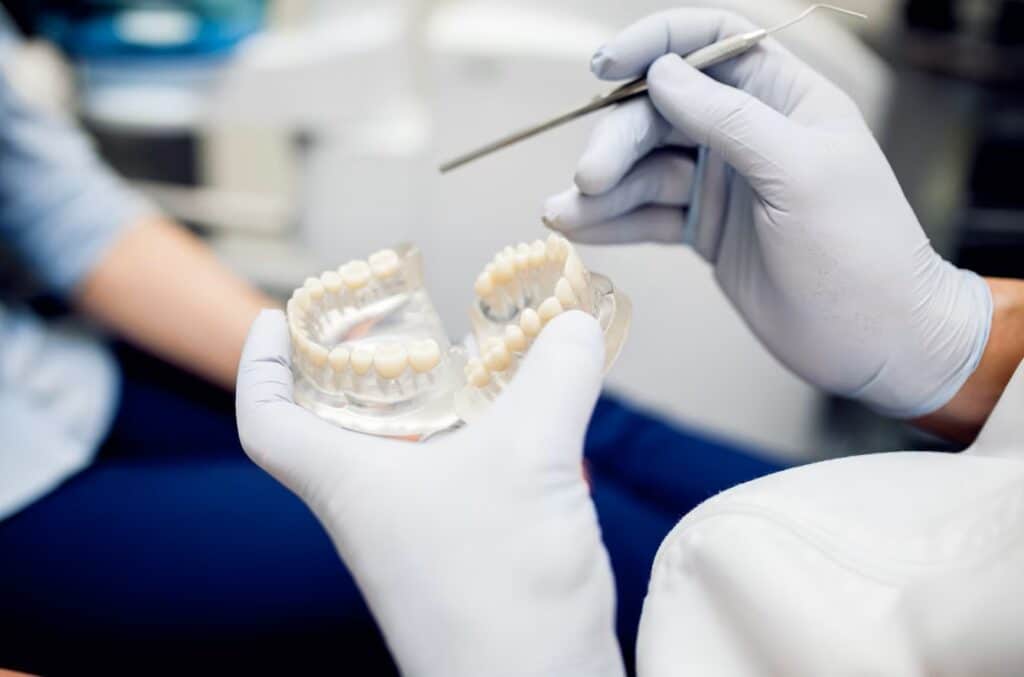Dental bridges play a crucial role in maintaining a healthy, functional, and attractive smile, especially when dealing with missing teeth. When you lose a tooth, not only does it affect your appearance, but it can also impact how you chew and speak. A dental bridge can help fill those gaps, restoring both the function and beauty of your teeth.
Without treatment, missing teeth can cause other teeth to shift or lead to bite problems, which might result in further dental issues. Dental bridges serve as a reliable solution to these problems by securing artificial teeth in the space left by missing ones. This not only enhances your smile but also ensures that your oral health remains intact.
What Are Dental Bridges and How Do They Work?
Dental bridges are an effective way to replace missing teeth, bridging the gap with artificial ones. They consist of one or more artificial teeth and are secured with support from the adjacent natural teeth, commonly known as abutment teeth. These artificial teeth, called pontics, can be made from materials like porcelain, gold, alloys, or a combination. They are crafted to look and function like your natural teeth, helping you maintain a natural smile and proper dental function.
A dental bridge works by anchoring to the teeth on either side of the gap. These anchoring teeth are prepared by removing a portion of enamel to allow the placement of crowns. The pontic is then held in place by the crowns on the abutment teeth, effectively filling the space left by the missing teeth. This provides stability, prevents surrounding teeth from shifting, and restores the ability to chew and speak properly.
Beyond aesthetics, bridges help maintain the shape of your face and even distribute the forces in your bite by replacing missing teeth. With the proper care, a dental bridge can last many years, offering a reliable solution to improve both your smile and overall dental health.
The Different Types of Dental Bridges: Choosing the Right Option
Choosing the right type of dental bridge depends on your specific dental needs. Here’s a look at some common types:
1. Traditional Bridges
These are the most common type and involve creating a crown for the tooth or implant on either side of the missing tooth, with a pontic in between. Traditional bridges are suitable when natural teeth surround the gap.
2. Cantilever Bridges
Used when there is only one tooth adjacent to the gap, cantilever bridges anchor on one side only. They are less common and typically used when only a single anchor tooth is available.
3. Maryland Bonded Bridges
Also known as resin-bonded bridges, these involve a metal or porcelain framework bonded to the back of the adjacent teeth. They are mostly used for replacing front teeth and require minimal alterations to the adjacent teeth.
4. Implant-Supported Bridges
Instead of crowns or frameworks, these bridges are supported by dental implants. They are typically used when more than one tooth is missing, providing sturdy and lasting support without relying on natural teeth.
Choosing the best bridge depends on factors like the location of the missing tooth, the condition of surrounding teeth, and your personal preferences. Consulting with your dentist can help you determine the most suitable option, ensuring comfort and functionality in your new smile. Each type has its benefits and limitations, so understanding these can greatly aid in making an informed choice for your dental health.
Benefits of Dental Bridges: Why They Matter for Oral Health
Dental bridges offer numerous benefits that go beyond merely filling the gap left by missing teeth. One of the primary advantages is the restoration of your ability to chew and speak properly. Gaps in your teeth can make these everyday tasks difficult and uncomfortable, but a bridge helps return normal function to your mouth.
Bridges also play a critical role in maintaining the shape of your face. Missing teeth can lead to bone loss and changes in your facial structure over time, potentially causing a sunken appearance. By supporting the remaining teeth and preserving bone structure, dental bridges help keep your face looking natural and healthy.
Another significant benefit is the prevention of remaining teeth shifting out of position. When a tooth is missing, the surrounding teeth might drift into the empty spot, leading to bite problems or misalignment. A dental bridge acts as a barrier, keeping your teeth in their correct positions and contributing to a well-aligned bite.
These prosthetics are designed to be durable and, with proper care, can last many years. This long-term solution adds to their appeal, giving you confidence in your oral health. Additionally, bridges can enhance your smile’s appearance, making it easier to smile without feeling self-conscious about missing teeth. For many, this boost in confidence is one of the most valued benefits of choosing dental bridges.
Caring for Dental Bridges: Tips for Longevity and Maintenance
Taking care of your dental bridges is crucial to ensuring they last as long as possible. Good oral hygiene is the foundation of care for dental bridges and involves regular brushing and flossing. Use a soft-bristle toothbrush and fluoride toothpaste to gently clean your teeth and bridge.
Flossing is equally important to remove any food particles or plaque from underneath and around the bridge. Your dentist might recommend a special floss threader or an interdental brush for more effective cleaning around the bridge. It’s essential to keep the area around your bridge clean to prevent gum disease or decay in the teeth that support it.
Regular dental check-ups are vital to maintaining your bridge. During these appointments, your dentist will check the bridge for signs of wear and ensure the adjacent teeth remain healthy. Professional cleanings contribute to the longevity of your bridge by eliminating any plaque build-up that home cleaning might miss.
Avoiding certain habits can also help extend the life of your dental bridge. Chewing on ice, hard foods, or using your teeth to open packages can damage the bridge. If you grind your teeth, speak with your dentist about options like a night guard to protect your bridge and teeth.
These simple but effective care strategies can help ensure that your dental bridge remains strong and functional, supporting your oral health for years to come.
Conclusion
Dental bridges are a vital solution for those missing one or more teeth, offering both aesthetic and functional benefits. They help restore your smile, improve speech and chewing, and maintain the structure of your face. By filling gaps, bridges prevent neighbouring teeth from shifting, which can lead to misalignment or bite problems. Their impact on oral health is substantial, providing a solid alternative to more extensive procedures like implants or dentures.
Choosing the right type of dental bridge is essential, and your dentist can guide you in selecting one that suits your needs best. Whether you opt for traditional, cantilever, or an implant-supported bridge, each type offers distinct benefits and might vary in suitability depending on your dental structure. Understanding these options can empower you to make informed decisions about your dental care.
At Pickering Dental Services, we understand the importance of maintaining a healthy smile and work closely with you to provide the best dental care possible. If you’re considering dental bridges or want to learn more about your options, contact us today. Our cosmetic dentist in Pickering is dedicated to helping you achieve a healthy, confident smile that lasts.



